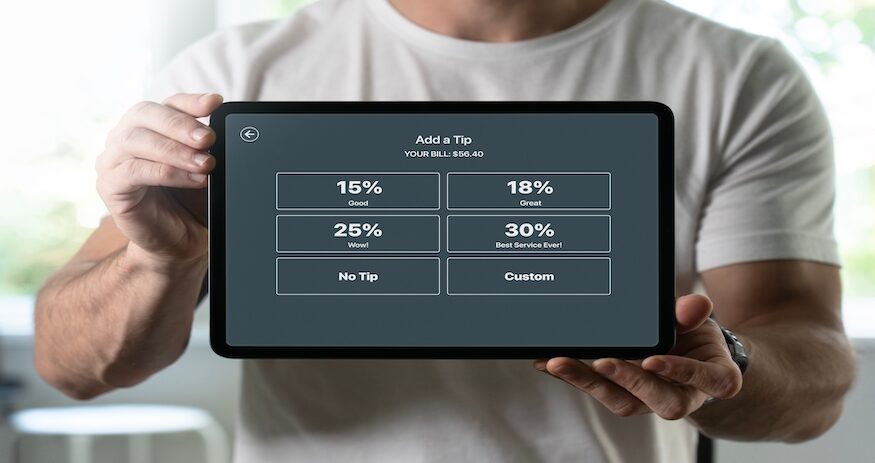Navigating the Impact of Tip Inflation: The Rise of Gratuity Expectations in Colorado and Beyond
Exploring the expansion of tipping Practices and its impact on consumers and service workers.
Jeff Rundles //April 23, 2024//


Navigating the Impact of Tip Inflation: The Rise of Gratuity Expectations in Colorado and Beyond
Exploring the expansion of tipping Practices and its impact on consumers and service workers.
Jeff Rundles //April 23, 2024//
For all my life, what with all of the various jobs I have had over the decades, for whatever reason I have never had a job where I received tips, or gratuities, as part of my income.
I have been around tipping, of course, as I have had many friends over the years who were food servers, or caddies, or any number of service industry employees where tipping was not only a part of their income but essentially the core of their income. After all, there has always been a second, and lower minimum wage for people employed in classic tipped positions.
For instance, the current minimum wage in Colorado is $14.42 per hour for most positions, with an $11.40 per hour level set for positions considered a “tipped wage” position. In Colorado, a “tipped employee” is anyone who in the normal course of their job receives more than $30 in tips per month.
READ: Colorado Cities Soar in Milken Institute’s Best Performing Cities Report 2023
The “tipped employee” definition is key these days as the marketplace is undergoing an enormous shift in tipping behaviors, and is, at least in my estimation, heading into untenable territory.
I have had a lifetime of gladly offering gratuities in service situations, and I have never really given it a second thought. They live on tips, so tip them. But in the last several years the tipping environment has changed immensely, where we now routinely see tip jars and tip lines on credit card statements and iPad payment screens at establishments of every stripe. I call this the Starbucks Phenomenon, as the coffee house explosion brought about the first example of counter staff expecting tips that I recall.
Now it’s everywhere. Bakeries. Fast-food sandwich shops. Markets. Donut counters. Delivery services. Tradespeople.
The real explosion in tipping came along with the coronavirus pandemic where we all relied upon a myriad of service workers — “essential workers” — just to get our hands on the necessities of life.
It was a big Thank You for the risks they were taking on our behalf.
The pandemic is over, thank the Lord, but the ubiquity of the in-your-face guilt screens of tipping shame have only expanded. 15%. 20%. 25%. Custom Amount. Clerks at counters and workers nearly everywhere — places and people that never were included in the tipping atmosphere — are happily turning that screen around to you with their smiling face silently exhorting, or extorting, you to hit one of the buttons and pay more.
READ: In Fort Collins, Small-Box Mercantile is the Latest in One-Stop Shopping
I’ve even heard of food delivery services that ask for a tip in advance and clearly indicate that the tip will factor in the speed of the delivery. There are all kinds of news stories addressing the new “guilt tipping” and “tip-flation” instances, and there are plenty of reasons to explore.
The most interesting of these is the idea that the rise in tip screens on those check-out iPads is really a way for the establishments themselves to avoid or diminish raising the pay of the counter personnel. So in that regard we are not only tipping the worker behind the counter but also the company running the business as well.
I guess I would rather see the worker get the extra money directly right there and then, but it’s a little disingenuous. Rather, they could raise the worker pay, and increase the price of a sandwich by two bucks and attain the same outcome, but either way the net effect is that all kinds of things now cost 15% to 25% more than they did before and some people — no tippers — aren’t paying their share.
Many of these businesses are also raising prices and adding service fees and credit-card fee premiums on top of tips anyway.
I don’t really begrudge anyone in the service industry getting a tip; I just object to the method by which a broader gratuity economy has come into being. Tip creep, if you will.
In the end, however, it isn’t really the whole tip-flation thing that is the essential question.
A tip — and the amount of a tip — has traditionally been a reward, or a penalty, for the level of service received. So, with all of the added areas of tipping sprouting up all over the place ad nauseam, are we being served?
That’s debatable.
Jeff Rundles is a former editor of ColoradoBiz and a regular columnist. Read this and Rundles’ blog, Executive Wheels, at cobizmag.com or email him at [email protected].
P
























